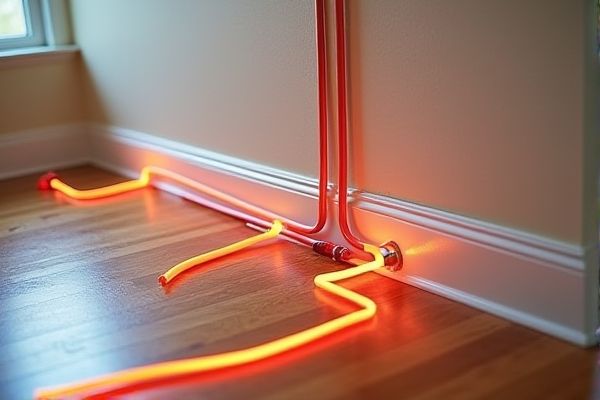
Radiant heat delivers warmth directly to floors and objects, creating a consistent and energy-efficient temperature, while baseboard heat relies on convection to circulate warm air throughout the room, often leading to uneven heat distribution. Discover how choosing the right heating system can improve Your home's comfort and energy savings in the rest of this article.
Table of Comparison
| Feature | Radiant Heat | Baseboard Heat |
|---|---|---|
| Heating Method | Infrared radiation warms objects and people directly | Convection heats air near the baseboard to circulate warmth |
| Installation Location | Underfloor or behind walls/ceilings | Along baseboards around room perimeter |
| Energy Efficiency | High efficiency due to direct heat transfer | Moderate efficiency with some heat loss |
| Comfort Level | Even, consistent warmth without drafts | Localized heat with potential cold spots |
| Installation Cost | Higher initial cost, especially for retrofits | Lower upfront cost and easier installation |
| Maintenance | Minimal maintenance required | Requires periodic cleaning and possible repairs |
| Heating Speed | Slower warm-up time | Quicker heat delivery |
| Noise Level | Silent operation | Possible slight noise from expansion or fan (if present) |
| Common Usage | New construction, luxury homes, bathrooms | Residential homes, apartments, supplemental heating |
Overview of Radiant Heat and Baseboard Heat
Radiant heat warms your space by transferring heat directly through floors, walls, or ceilings, providing consistent and energy-efficient comfort. Baseboard heat relies on convection, using heated air rising from electric or hydronic units along the baseboards to distribute warmth. Understanding these fundamental differences helps you choose the most effective heating system for your home's layout and energy goals.
How Radiant Heating Systems Work
Radiant heating systems operate by circulating warm water through tubing installed beneath floors or panels, directly transferring heat to surfaces and objects in a room. This method provides consistent, even warmth by radiating heat upward, reducing energy loss compared to baseboard heaters that rely on convection to heat air. The efficiency of radiant heat contributes to enhanced comfort and lower energy bills in residential and commercial buildings.
How Baseboard Heating Systems Operate
Baseboard heating systems operate by circulating hot water or electric coils along a series of metal fins that radiate heat into the surrounding air through convection. As the warm air rises, cooler air is drawn in at the base, creating a continuous and efficient heat distribution throughout the room. This method contrasts with radiant heat, which transfers warmth directly to objects and people without significantly heating the air.
Installation Process: Radiant vs. Baseboard Heat
The installation process for radiant heat involves embedding heating elements or tubing within floors, requiring subfloor preparation and often professional expertise for proper placement and connection to a heat source. Baseboard heat installation typically consists of mounting electric or hydronic units along baseboards, making it less invasive, quicker, and more accessible for DIY projects compared to radiant systems. Radiant systems demand more upfront work but offer discreet heating, while baseboard systems are simpler to install but more visibly integrated into room design.
Energy Efficiency Comparison
Radiant heat systems typically offer higher energy efficiency than baseboard heating by directly warming objects and surfaces, reducing heat loss and enabling lower thermostat settings. Baseboard heaters rely on convection to heat air, often resulting in uneven temperature distribution and greater energy consumption. Studies indicate radiant heat can lower energy use by up to 30% compared to conventional baseboard systems in residential applications.
Comfort and Heat Distribution
Radiant heat provides consistent warmth by directly heating objects and surfaces, resulting in even heat distribution without cold spots, enhancing overall comfort in your space. Baseboard heat relies on convection, warming the air near the floor which can create uneven temperature zones and less uniform heat distribution. Choosing radiant heat often leads to a more comfortable environment with stable temperatures and reduced drafts compared to baseboard heating.
Cost Analysis and Long-Term Savings
Radiant heat systems typically have higher upfront installation costs compared to baseboard heating but offer superior energy efficiency by distributing heat evenly and reducing heat loss. Baseboard heat often incurs lower initial expenses but may result in higher operational costs due to uneven heating and greater energy consumption over time. Long-term savings with radiant heat arise from increased comfort, lower energy bills, and reduced maintenance, making it a cost-effective option despite the initial investment.
Maintenance Requirements and Lifespan
Radiant heat systems typically have lower maintenance requirements due to fewer moving parts and less exposure to dust compared to baseboard heat, which often requires regular cleaning to prevent dust buildup and ensure efficient operation. Radiant heating can last up to 30-50 years with proper installation and minimal upkeep, while baseboard heaters generally have a shorter lifespan of around 15-20 years, largely dependent on usage and maintenance. Your choice impacts long-term maintenance efforts and system durability, making radiant heat a more durable option for consistent, low-maintenance heating.
Environmental Impact and Sustainability
Radiant heat systems typically have a lower environmental impact due to their higher energy efficiency and ability to evenly distribute warmth, reducing overall energy consumption. Baseboard heating often relies on electric or hydronic systems that may produce more emissions depending on the energy source. Your choice affects sustainability by influencing energy use patterns and reliance on renewable energy options, with radiant heat often presenting a greener alternative.
Choosing the Best Heating System for Your Home
Radiant heat systems provide efficient, even warmth by heating floors or walls directly, making them ideal for maintaining consistent indoor temperatures while reducing energy costs. Baseboard heat offers easy installation and zone control, allowing homeowners to heat specific areas independently but may result in less uniform heat distribution. Evaluating factors such as energy efficiency, installation complexity, and room size will help determine the best heating system for your home's comfort and budget.
 homyna.com
homyna.com